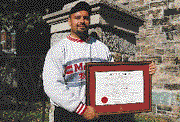Law Library judged a success
 On September 17, Quebec Lieutenant-Governor Lise Thibault, Premier Lucien Bouchard, benefactor Nahum Gelber, BA'54, BCL'57, and representatives from the legal community were all on hand for the opening of the new Nahum Gelber Law Library at the corner of Peel Street and Dr. Penfield Avenue. Designed by Montreal architect Dan Hanganu, the $11.5-million building replaces a law library that was considered one of the worst in the country -- poorly ventilated, absurdly cramped, and far too noisy. On September 17, Quebec Lieutenant-Governor Lise Thibault, Premier Lucien Bouchard, benefactor Nahum Gelber, BA'54, BCL'57, and representatives from the legal community were all on hand for the opening of the new Nahum Gelber Law Library at the corner of Peel Street and Dr. Penfield Avenue. Designed by Montreal architect Dan Hanganu, the $11.5-million building replaces a law library that was considered one of the worst in the country -- poorly ventilated, absurdly cramped, and far too noisy.
The new facility -- much more befitting the venerable faculty, which celebrates its 150th anniversary this year -- was paid for by alumni, law firms and friends of the faculty, with no government funding. "We're thrilled that so many people supported us," said Dean of Law Stephen Toope.
"I want to highlight the generosity of McGill's alumni," Premier Bouchard told the crowd gathered for the official opening, making special mention of Gelber, who wielded a giant library access card for the ceremonial opening of the library doors.
The building is linked by a glass atrium to Chancellor Day Hall, where the faculty is located. A giant, triangular window on the third floor looks out onto Dr. Penfield Avenue and the Montreal skyline, while the entrance features a large spiral staircase and striking sculpture by artist Barry Flanagan. A motto taken from Euripides is carved into the side of the building: "To leave no stone unturned." All study areas are wired for laptop computers and connected to the Internet, and many of the rooms in the building are named for individuals and law firms who contributed to the project. Students, too, were deeply involved, influencing the library's design through a committee that had the Dean's sympathetic ear. Among their requests was lots of table space for the array of legal tomes with which they are wont to surround themselves.
Students, faculty and administrators alike are thrilled with the new building. The next step, according to law librarian Robert Clarke, is to improve the library's collections, which have also lagged behind the faculty's national reputation.
|
Yard sale ends suspense
 The McGill University Health Centre has announced the site for the planned Montreal "superhospital," which will merge the Royal Victoria, Montreal General, Children's and Neurological hospitals. The location the subject of speculation for over a year will be Glen Yard, a 43-acre plot of land on the borders of Montreal and Westmount. After a year of negotiations, the MUHC has bought the site from CP Rail for $23 million. CP had been using Glen Yard for railcar storage. The McGill University Health Centre has announced the site for the planned Montreal "superhospital," which will merge the Royal Victoria, Montreal General, Children's and Neurological hospitals. The location the subject of speculation for over a year will be Glen Yard, a 43-acre plot of land on the borders of Montreal and Westmount. After a year of negotiations, the MUHC has bought the site from CP Rail for $23 million. CP had been using Glen Yard for railcar storage.
"It is a large enough site to allow for flexibility in design," said architect Philip Webster, Chairman of the MUHC's site selection work group, "and is in an area conducive to the creation of a healing environment." MUHC leaders were visibly pleased during the press conference held in early November, a week after word of the deal had leaked out in the Montreal Gazette.
Still, the announcement did lend some new controversies to an already controversial project. Some critics consider the location outside of the downtown core, which may prove inconvenient for seniors and others who have to travel to the west end of the city for care, and others claim it is too far from the University. Westmount residents are also wary of the site because of the increased traffic, noise and disturbances it could bring, and Westmount mayor Peter Trent said there could be "very strong opposition."
Finally, there is the site itself, which will need a major clean-up to deal with all of the residual pollutants like diesel fuel from the railcars that have been stored there for years. CP will be responsible for the clean-up and claims it should not pose much of a problem.
Construction of the new health centre is expected to be complete by 2004.
|
Excellent e-zine

The image of the on-line magazine conjures up something wired, wacky and "out there," with a young, Much Music-type editor to match. So how did 50-plus Arts graduate Evelyn Hannon, BA'89, come to found Journeywoman, a prize-winning publication which is issued in electronic format only?
"People always ask that question, especially when they find out I'm approaching 60. And it's not because I'm technically brilliant -- my daughters always call me digitally deficient." Hannon says she started the travel magazine "after I strapped on a backpack for the first time at the age of 42 and found there were no manuals for women travelling alone."
A copious note-taker during her trips, Hannon started Journeywoman in 1994 as a small paper publication issued three times a year. As she began hearing from readers around the world, she decided the web could help her reach the huge potential market and provide the interactivity which has become a hallmark of the magazine. In a style Hannon describes as "quiet but funky," Journeywoman offers what the glossy travel magazines don't -- information on surviving after dark, dressing appropriately according to local custom and culture, travelling when pregnant and finding restaurants and hotels friendly to women on their own. There's lots of first-hand reporting, features on packing and travel-related love stories, and lists of travel tips, including where to find the best Black Forest cake in Peru and how to get access to e-mail in Germany.
Hannon's publication has won a suitcase full of awards since going online in two years ago. Named a recipient of a 1998 Apex Award for Publication Excellence (for the third time), Journeywoman was praised for the "original and helpful content" with its "unique friendliness and practicality." A Cyber Excellence Award was given for its "terrific pages" and "great design" and its site has been named everything from "hot" to "cool" to "elite." Even if you never plan to leave home, Journeywoman is fun to visit. Check it out at www.journeywoman.com.
|
Soap stud
 McGill graduates turn up in some of the strangest places. Soap opera fans may want to flip the channel to ABC's All My Children, where they will catch hunky Cameron Mathison, BEng'93, starring as sexy con man Ryan Lavery. The former McGill basketball captain has been steaming up afternoon TV since January, stealing hearts and breaking up marriages (on screen only, we are told). Mathison caught the acting bug after a few years of modelling for the likes of Versace, Armani and Hugo Boss, and has played roles in F/X: The Series, The Defenders, and the movie 54, about the infamous New York disco. Now that he's a soap star, Mathison has an official fan website, www.cameronmathison.com, and sets female pulses a-flutter wherever he makes public appearances. "It's weird," he told the Ottawa Citizen, "because a lot of the women sort of lose control and scream and cry and stuff." McGill graduates turn up in some of the strangest places. Soap opera fans may want to flip the channel to ABC's All My Children, where they will catch hunky Cameron Mathison, BEng'93, starring as sexy con man Ryan Lavery. The former McGill basketball captain has been steaming up afternoon TV since January, stealing hearts and breaking up marriages (on screen only, we are told). Mathison caught the acting bug after a few years of modelling for the likes of Versace, Armani and Hugo Boss, and has played roles in F/X: The Series, The Defenders, and the movie 54, about the infamous New York disco. Now that he's a soap star, Mathison has an official fan website, www.cameronmathison.com, and sets female pulses a-flutter wherever he makes public appearances. "It's weird," he told the Ottawa Citizen, "because a lot of the women sort of lose control and scream and cry and stuff."
Ah, yes. A Civil Engineering degree can do that...
|
Special delivery

Physical Education graduate Samir Chahine left McGill in a hurry last spring. He'd just had a phone call telling him he'd been drafted by the Edmonton Eskimos of the Canadian Football League. Here was the possibility of fulfilling his childhood dream of playing professional football, and the young man went west so fast that he left a few things behind -- his degree, for instance.
A three-time All-Canadian offensive guard as a McGill Redman and a medal-winning shot-putter, Chahine earned a spot with the Eskimos over the summer. When his team came to Montreal this fall for a weekend game against the Alouettes at McGill's Molson Stadium, the rookie asked his coach for permission to stay an extra day. He was at the Admissions and Registrar's Office first thing Monday morning to take care of the unfinished paperwork. Then, with his framed diploma tucked under his arm, he had one more important errand. Before returning to Edmonton, he flew to Toronto to present the diploma to his proud mother.
Farewell to old friends
 Many graduates have been on the receiving end of a hearty handshake from silver-haired whirlwind David Johnston at branch events as he conducted McGill's business around the world. He travelled tirelessly for the University during his 15-year tenure as Principal, and a McGill News article at the time he stepped down in 1994 recalled a typical departure from Montreal, with Johnston "tying a McGill tie while gripping the steering wheel with his knees in a dash to get to the airport." Many graduates have been on the receiving end of a hearty handshake from silver-haired whirlwind David Johnston at branch events as he conducted McGill's business around the world. He travelled tirelessly for the University during his 15-year tenure as Principal, and a McGill News article at the time he stepped down in 1994 recalled a typical departure from Montreal, with Johnston "tying a McGill tie while gripping the steering wheel with his knees in a dash to get to the airport."
He'll be leaving Montreal and McGill for good next year as he takes on the presidency of the University of Waterloo, an appointment announced in October. "I never expected to do more than one term at McGill, much less three," he says. "And once I returned to being a law professor, I never expected to go back to university administration. I wanted to be sure that I could still contribute through teaching and writing."
So for several years he concentrated on being an academic, producing his sixth book and politely refusing the offers that came from schools in both the U.S. and Canada. Last year, when a consultant asked if there was anything that would change his mind, he finally thought there might be. "I said I felt my talents would be suited to a challenge involving innovation and a willingness to take risks. Waterloo is only 40 years old and has been quite innovative. Its strengths are in science and technology, and I have become very interested in how we integrate that into the human condition."
Johnston says he and his wife Sharon will leave "with many a tear. Montreal is home and we'll miss our many friends here at McGill. We're also leaving behind our five daughters -- that's quite a legacy." All the children -- and their parents -- have attended McGill and among them have earned everything from a summer school certificate to a PhD. Johnston laughs, "With the staff tuition discount, I can't imagine another family in Canada that's had a higher quality education at a lower price than ours!"
He says he'll never forget those visits with alumni and the warm welcome he always received. "If I missed a single branch, I'm not aware of it. I don't think there's a capital anywhere in the world where I can't find a friend to call on or share a meal with."
|
Medical marvel

The MJM is a glossy journal of peer-reviewed research articles contributed by scientists from around the world. So what's the big deal? Well, the McGill Journal of Medicine, now in its fourth year of publication, is written, edited and produced entirely by students and happens to be the only one of its kind in the English-speaking world.
The idea of founding editor Jonathan Lim, the journal grew out of his interest in finding a summer project following his first year of medical studies. He decided that a journal would provide a showcase for the high quality research being done by fellow students. He recruited an editorial team who quickly put together "a two-inch thick binder full of ideas." Sponsors were soon in place, along with some willing management students who helped on the business end. The team invested in training in desktop publishing, organized some faculty-run workshops on editing and put out a call for articles.
The response was slow at first, so the editors simply pushed back the deadline. Finally, things began to come together and the first issue appeared in the spring of 1995, arriving from the printer just as the champagne corks popped at the launch party.
Since then, the MJM has garnered great reviews and broadened the scope of its articles, which include a feature on the interrelationship between humanities and medicine and a section which offers several articles focusing on a particular medical specialty.
A review in the New England Journal of Medicine said "McGill's students deserve high praise for a thoroughly professional entry into the world of medical publishing," and the Journal of the American Medical Association says "MJM may prove to be an important forum for those who will be the leaders in medical science during the 21st century." |
|
|











